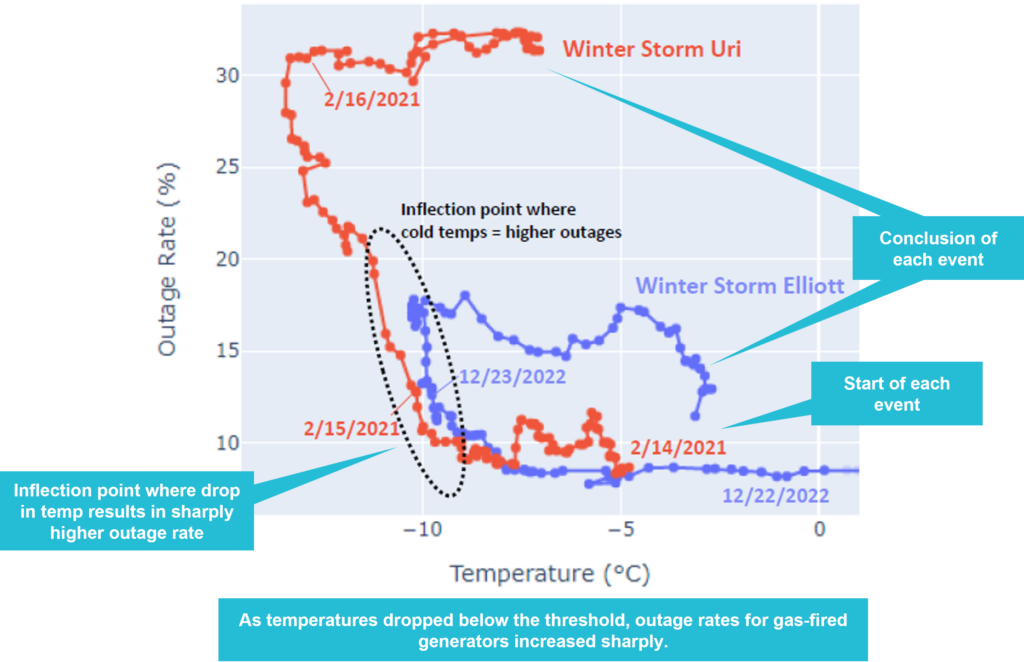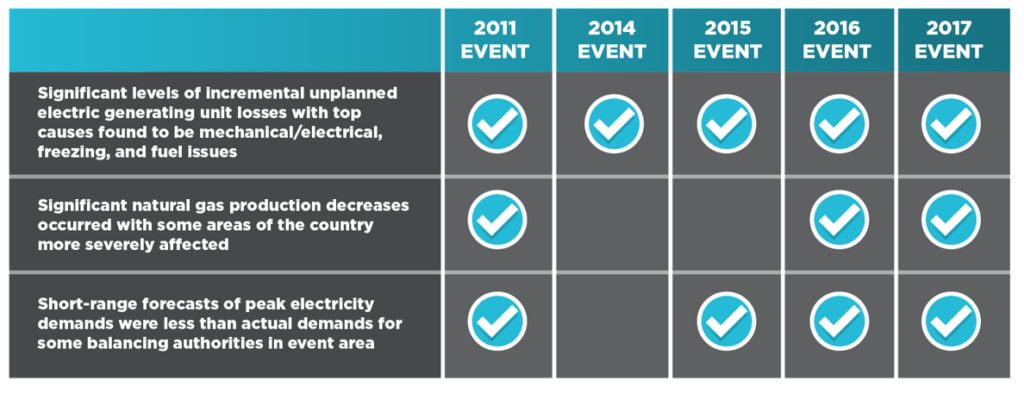
While families gathered for a long holiday weekend in late December 2022, the bulk power system narrowly avoided cascading outages across the Eastern Interconnection.
Winter Storm Elliott brought Arctic air and strong winds that resulted in unplanned outages of more than 70,000 MWs of generation. In response, several balancing authorities in the southeastern United States ordered firm load shed exceeding 5,000 MW.
Elliott was a close call, but it was not an outlier. Recent winter events reveal conventional generation experiencing forced outages due to cold temperature equipment failures and natural gas fuel supply issues.
Recent winter storms are a useful example of some of the potential resource adequacy challenges that grid operators may face in the future, as beneficial electrification increases demand during extreme winter events.
According to the North American Electric Reliability Corporation (NERC), conventional generation poses notable risk to the reliability of the bulk power system. The first key finding in its most recent State of Reliability report notes:
“The reliability of conventional generation is significantly challenged by more frequent extreme weather, high-demand conditions, and a changing resource mix, resulting in higher overall outage rates and surpassing transmission in their contribution to major load loss events.”
To examine this concept further, ScottMadden relied on NERC’s Generation Availability Data System (GADS) to examine the reliability of conventional generation facilities during Winter Storm Uri.
Our analysis focused on conventional generation units in two regions significantly impacted by Winter Storm Uri—Electric Reliability Council of Texas (ERCOT) and SERC Reliability Corporation (SERC), whose area covers most of the Southeast.
Reliability performance was evaluated using the equivalent forced outage rate (EFOR)—a metric that depicts the rate of forced outages and forced derates (i.e., unplanned unavailability). NERC’s data is limited and blinded, but an examination of the causes to which those outages were attributed pointed to a mix of equipment failures and fuel supply issues.
We considered three separate technologies in our analysis: steam turbines, combined cycles, and combustion turbines. For each technology, we compared the capacity-weighted EFOR value from February 2021 to capacity-weighted EFOR values from the previous five years (2017–2021).
Results varied somewhat depending on capacity range, vintage, and technology type, but the conclusion was consistent: A surprisingly large number of conventional generation units were unavailable to serve load due to a difficult to disaggregate mix of forced outages attributable to unexpected mechanical failures and fuel supply disruptions during the extreme winter weather.
The analysis summarized below also suggests that the biggest differences in outage rates (i.e., those that experienced higher rates of failure in February 2021 compared to the previous five years) were observed among the largest and newest units in the samples. For instance, among steam turbines, the outage rates of the newest units increased 80% from 7.02% over the previous five years to 12.64% in February 2021, compared to more modest increases observed among the older units.
Weighted EFOR by Technology, Capacity, and Vintage: February 2021 vs. Previous 5 Years
| Capacity and Vintage Bins | Steam Turbines | Combined Cycle Blocks | Combustion Turbines | |||
| 5 Year | Feb 2021 | 5 Year | Feb 2021 | 5 Year | Feb 2021 | |
| Small Units | 21.35% | 27.35% | 3.26% | 8.81% | 28.46% | 39.24% |
| Medium Units | 13.09% | 14.41% | 6.77% | 12.47% | 57.15% | 54.37% |
| Large Units | 9.64% | 13.14% | 2.86% | 5.00% | 14.59% | 32.39% |
| Oldest Units | 16.67% | 16.02% | 6.56% | 13.01% | 51.13% | 45.60% |
| Middle-Aged Units | 10.56% | 13.49% | 3.87% | 8.40% | 21.78% | 42.40% |
| Newest Units | 7.02% | 12.64% | 2.89% | 3.73% | 8.62% | 19.98% |
A recent Energy Systems Integration Group (ESIG) analysis highlighted the fact that there appears to be an inflection point at -7° to -10°C (19° to 14°F). As temperatures dropped beyond that point during Winter Storm Uri for an extended period, the outage rates for gas-fired generators increased markedly from ~10% to more than 30%.

Ensuring reliability during winter storms may become more challenging as regions shift from summer electricity demand peaks to dual or winter peaks.
Beneficial electrification, or the process of switching from combustible fuel to electricity while providing a comparable service, is a growing driver of the shift in peak load. More specifically, the adoption of electric heat pumps, which can provide both heating and cooling, increases electricity demand during extreme winter events.
This trend may accelerate, as heat pump sales exceeded gas-powered furnaces in 2022. In addition, the Inflation Reduction Act offers generous rebates for medium- and low-income households and tax credits for all households installing heat pumps.
In addition to growing winter load, the scope and extent of extremes are also increasing. The challenge can be seen in the differences in the extreme temperatures experienced in late 2022 with Winter Storm Elliott and those experienced the year before during February 2021’s Winter Storm Uri.
As the graphic below illustrates, during Uri, some portions of the central United States experienced temperatures that were as much as 10° to 25°F colder than what was experienced during Elliot. As discussed earlier, those variations matter to reliability performance.
Difference in Low Temperatures Experienced – Uri vs. Elliot

What Should Be Done: Learn From the Past
Winter Storm Elliott prompted the Federal Energy Regulatory Commission (FERC) and NERC to open a joint inquiry into the operations of the bulk power system. A status update on the joint inquiry noted that “early observations reinforce themes and recommendation from prior inquiry reports,” which date back to 2011. Specific themes include:
These themes are not new, but rather show strong similarities to previous extreme cold weather events:

The preliminary findings point to numerous recommendations from previous reports that, if implemented, could have helped mitigate the effects of Winter Storm Elliott according to FERC.
In January 2004, an extended cold snap constrained natural gas pipelines, offering a first glimpse into regional fuel security risks during extreme cold. ISO New England has been vocal about fuel supply risks ever since.
Forced outages during Winter Storm Elliott required the grid operator to implement Operating Procedure No. 4 (OP-4), which details actions during capacity deficiencies. This course of action prompted an inquiry from members of the U.S. Senate delegation.
In a response letter, ISO New England President and CEO Gordon van Welie offered the following candid assessment:
“The potential for capacity deficiencies is a known, and accepted, possibility in planning a reliable power system. The solution to the problem is having operating procedures that can restore operating reserves, having sufficient capacity resources to make up the shortfall, and having an incentive structure in place to attract those resources to fill the gap. New England had all of these on December 24.”
Despite successfully maintaining reliability during Winter Storm Elliott, the region still faces significant challenges. For example, the region relies heavily on fuel oil for electric generation when natural gas supplies are constrained. Meanwhile, the continued closure of fossil generation will further challenge operations during extreme winter events.
ISO New England has successfully managed through many winter storms, but there is little margin for error. Additionally, a changing energy landscape may only further challenge operators during extreme winter events.
The growing challenge is clear.
Electrification will drive more and more electric systems to dual or winter peaks. At the same time, fossil-fired generation units face unique challenges and increased forced outages during extreme winter events, particularly at persistently low temperatures.
Meanwhile, past inquiries into cold weather events have resulted in well-documented recommended actions. In addition, ISO New England offers two decades of operational experience managing these risks.
Just one question remains: Will the industry take action to prevent the next near miss?
View More

Sussex Economic Advisors is now part of ScottMadden. We invite you to learn more about our expanded firm. Please use the Contact Us form to request additional information.